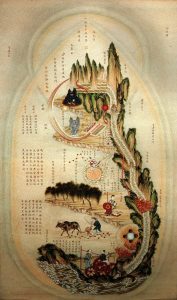met zachte ogen
Wandering the inner landscape
In our trade of Eastern medicine we work with a scope of whole-ness, no divisions between body, mind and emotions. However it sounds terrible wrong, we work from a certain dualism, the inner- and outer landscape. The outer landscape, the manifested body, is what we can see and hold: skin , bones, muscles, organs. The regular medicine treats us with this scope.
Eastern medicine however works from the inner landscape, it is where the manifested body comes from and will return to, more like a potentiality. It is a complete reflection of the world around us, has a sun and moon, water, mountains, forests, stars. In Shinto the priest trains himself to be standing in the sea till his head and wait for his inner sun to come up. All our functions are depicted here in a symbolic way. It is very abundant and complete, despite your history of sickness. Treatment and training form this landscape works on optimising the ki network, meridian system, consciousness.
It is the Rangaku movement in the first half of the 19th century after 2 centuries of being closed off from the rest of the world by the Tokugawa shogunate that first encountered this dualism. A group of scientists in Japan studied the anatomy books of the doctors that brought them from Holland and Germany to Deshima and found out that the actual body looked far more like the pictures depicted here than the symbolic representing of Chinese Medicine. Symbols versus manifestations.
As we work and train our skills and knowledge, it is very important to understand this. In Taoism they compare these two landscapes with the ocean and a wave: why working with the tip of a wave as you can move an ocean?

Here you see an image of the inner landscape, de Nei Jing Tu, which can be found in the White Cloud Temple in Beijing, carved in a stone, it can be inked and rubbed off on paper.
You can see a trunk, no limbs. The perineum is the lowest point, we see a boy and girl on a watermill representing the testes and ovaria. We can see the spine erecting from it right up to the top in the Kun Lun mountains, peaks high up. You can see Lao Tze here , symbol of wisdom and consciousness. Governing Vessel and Conception vessels meet in the front of the head, as the tongue can be placed behind the teeth to make the connection. The pagoda symbolises the throat which connects the head with the trunk where the organ symbols can be found: the herd boy who holds the ursa major is symbol for the Heart and innocence, the trees that symbolize the Liver-wood, the farmer and ox who plough the earth stand for the ability to train and cultivate the Earth for self-transformation. The woman weaving makes silk from the light of the moon and symbolises the diligent working of the Kidneys. The Kidney yang is symbolized by the fire, the Ming Men, the door to vitality or destination. In this picture there are many more symbols that I am trying to find out.
So far for the details, the big picture is to understand the three dantiens, the fields that generate the Jing, Ki and Shen. The earth produces the Jing, the heaven produces the Shen and man produces the Ki, the connection between yin and yang on the level of the Heart.
Jing is our vitality, and has the most dense quality of ki, shaped in time and space, most closely connected to the body, the bones, the marrow. The Jing is stored in our Kidneys and is rooted in our ancestors.
Ki is the connection, situated in the Heart, meeting of form and space. It is about contact, symbolized by a flower that connects you with your bosom friends, partner, children: you are not alone, you are connected. Emotions are felt here.
Shen is the most airy of the three, without form or time, it is placed between the eyes where the third eye is, a few cun deeper than the Yin Tang point. It symbolizes silence, consciousness, wonder.
As a shiatsu-practioner we have to be really present in our Jing to be rooted and vital. We can develop our touch and contact while working with the Heart to make a genuine and appropriate connection with our clients. Thirdly, we could develop our clarity and consciousness to see what can’t be noticed by our sense organs. I think most people remember their shiatsu training as building blocks from the Jing up: developing posture, kata , later on meridians and connection and on top of that the diagnostic skills.
The inner landscape offers a representation of the symbols that give us an idea how to train and develop ourselves to work with the ki landscape of our clients.
Hello I am strongly interested in buying your Book: Wanderung the inner landscape., it sounds Great and touches me deeply. How can I get one, whom I have to address ?
The book is out in English! and available via amazon.
enjoy!
Wheen someone writes an piiece off writing he/she retains thhe thought oof a user
iin his/her mid that how a user cann know it. Therefore that’s why thiks article iss
perfect. Thanks!